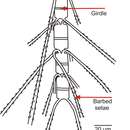Biology
provided by Diatom LifeDesk
C. concavicornis is a species of diatom associated with fish kills, but is not known to be harmful to humans.
- license
- cc-by-nc
- copyright
- Thessen, Anne
Toxicity
provided by Harmful Phytoplankton Project
No toxins produced but as diatoms pass through the primary and secondary lamallae of salmonids, setae cause some to get stuck in the interlamellar spaces (Albright et al. 1993) . This irritates the goblet cells leading to copious mucus production and eventual suffocation (Yang & Albright 1992). The same effects are seen in the edible red crab with the closely related species Chaetoceros convolutus (Tester & Mahoney 1995).
- bibliographic citation
- Guide to UK Coastal Planktonic Ciliates © 2001 DJS Montagnes, University of Liverpool http://www.liv.ac.uk/ciliate/
- author
- David J.S. Montagnes
Distribution
provided by Harmful Phytoplankton Project
The distibution of this species is cosmipolitan but absent from southern cold water region, common in northern cold water regions and temperate waters.
- Shevchenko O.G, Orlova T.Y and Hernández-Becerril D.U, (2006). The genus Chaetoceros (Bacillariophyta) form Peter the Great Bay, Sea of Japan. Botanica Marina 49: 236-258.
- Tester P.A and B. Mahoney, 1995. Impliciation of the diatom Chaetoceros convolutus in the death of red king crab Paralithoides camtschatica, Captains Bay, Unalaska Island, Alaska. Harmful Marine Algal Blooms, p95-100
- Evensen D.L and G.R Hasle (1975). The Morphology of some Chaetoceros (Bacillariophyceae) species as seen in the electron microscopes. Nova Hedwigia, Beih. 53: 153-184.
- C.Z. Yang & L.J. Albright (1992), Effects of the harmful diatom, Chaetoceros concavicornis on respiration of rainbow trout Oncorhynchus mykiss. Dis. Aquat. Org. 14: 105?114
- L.J. Albright, C.Z. Yang & S. Johnson (1993). Sub-lethal concentrations of the harmful diatoms, Chaetoceros concavicornis and C. convolutus, increase mortality rates of penned Pacific salmon. Aquaculture, 117:215-225
- Rines J.E.B and Hargraves P.E (1988). The Chaetoceros (Bacillariophyceae) flora of Narragansett Bay, Rhode Island, U.S.A. Bibliotheca Phycologica 79.
- bibliographic citation
- Guide to UK Coastal Planktonic Ciliates © 2001 DJS Montagnes, University of Liverpool http://www.liv.ac.uk/ciliate/
- author
- David J.S. Montagnes
Comprehensive Description
provided by Harmful Phytoplankton Project
Is a chain forming diatom, with each cell possessing seate narrower at origin than it tips, and all are bent towards lower end of the chain. Cells heterovalvate, apertures trapezoid like.
- bibliographic citation
- Guide to UK Coastal Planktonic Ciliates © 2001 DJS Montagnes, University of Liverpool http://www.liv.ac.uk/ciliate/
- author
- David J.S. Montagnes
Diagnostic Description
provided by Harmful Phytoplankton Project
Chaetoceros concavicornis forms straight chains. Cells heterovalvate; upper valve rounded, setae arising from near centre; lower valve flat, setae emerging from inside valve margin. Apertures trapezoid like. Girdle zone narrow (less than one third of the length of pervalvar axis). Setae thin at the base, wider outwards, and all bent towards the lower end of the chain, and outside line concave. External part of central possess a short tube (Evensen & Hasle 1975).
- bibliographic citation
- Guide to UK Coastal Planktonic Ciliates © 2001 DJS Montagnes, University of Liverpool http://www.liv.ac.uk/ciliate/
- author
- David J.S. Montagnes
Diet
provided by World Register of Marine Species
phytosynthetic
North-West Atlantic Ocean species (NWARMS)
- license
- cc-by-4.0
- copyright
- WoRMS Editorial Board
Distribution
provided by World Register of Marine Species
Probably cosmopolitan except in southern cold water regions, sometimes common in northern temperate and cold water areas.
North-West Atlantic Ocean species (NWARMS)
- license
- cc-by-4.0
- copyright
- WoRMS Editorial Board
Habitat
provided by World Register of Marine Species
pelagic or attached to various marine life
North-West Atlantic Ocean species (NWARMS)
- license
- cc-by-4.0
- copyright
- WoRMS Editorial Board
Morphology
provided by World Register of Marine Species
yellow brown in color, not green
North-West Atlantic Ocean species (NWARMS)
- license
- cc-by-4.0
- copyright
- WoRMS Editorial Board

